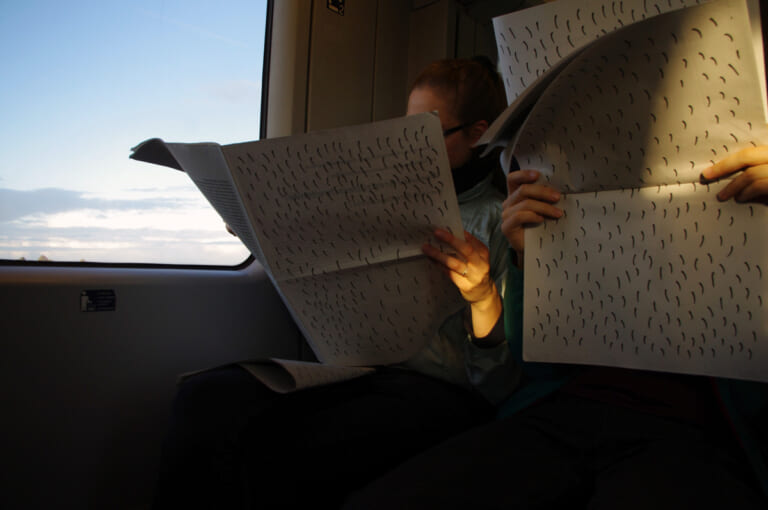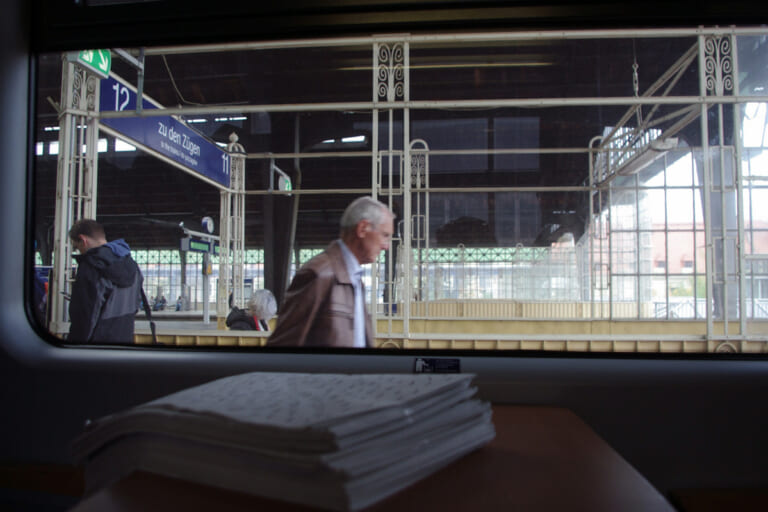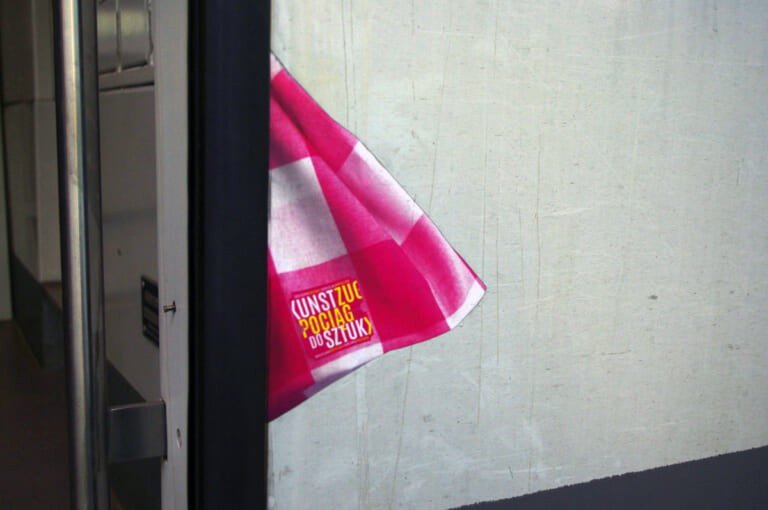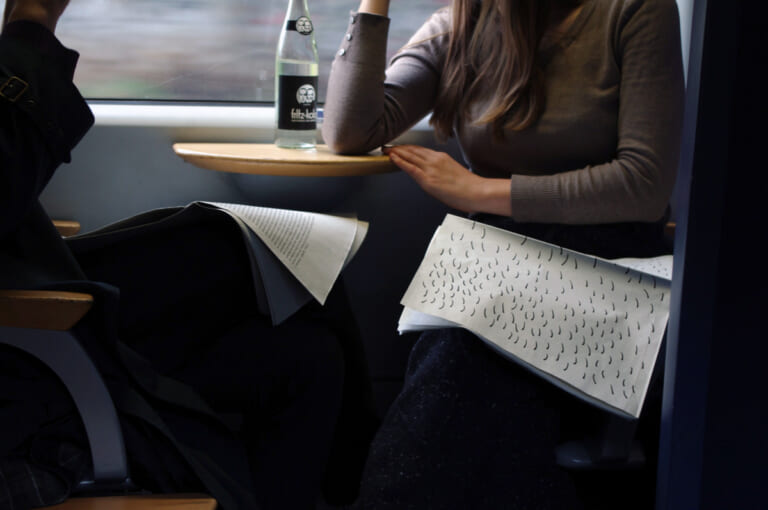Newspaper crossing the border (october 2016)
“The fine arts student Irène Mélix will present a newspaper in the train in autumn in which artists and politically involved people will contribute. The newspaper is dealing with the figure of the crosser, the How?, Where? and Why? of borders as well as the border region between Poland and Germany.”
The newspaper will be available in the train for free at the following times on the dates mentiones above:
12:08 Uhr Dresden Hbf
15:44 Uhr Wroclaw Glówny
participating artists:
Lilli Döscher, Anne Reiter, Theresa Schnell, Lea Zepf, Franziska Goralski, Anna Erdmann, Sophie Lindnder, Martin Wiesinger
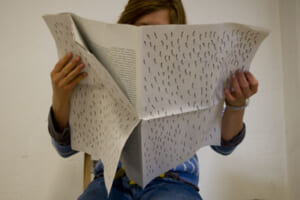
Foreword of the newspaper
(Irène Mélix)
____WHAT IS IT ALL ABOUT? [easy access] The newspaper that Irène Mélix made with other artists is called Grenzgängerin. It was on a train that travels back and forth between Germany and Poland. The newspaper is about borders and what it’s like to stand between different things. The Grenzgängerin is a character from literature.____
Europe rethought the border bar and made it a border belt. The toll bar has been moved out of sight. Who is the one crossing the border? And what is her history?
The “Dresden-Wroclaw-Express” travelled cross-border between Poland and Germany until 2015. The train crosses the german Grenze and the polish granica at the same time (hence the origin of the old-slavic granica). For financial reasons, the service terminated a couple of years ago. From this year on, a new connection was created, slower to cross the border than its predecrosser. The newspaper you are holding in your hands can hopefully condense the extra travel time to a point where it becomes Intense.
The border in territorial terms: negotiated, drawn, divided, classified, contractually concluded upon, controlled, monitored, defended, constructed. To be or not to be stopped, to run through, to percolate, to drive across, to overcome, to pass over, to overwrite, to break through, to tear down, to walk across.
A border appears as a territorial mark, that for instance separates one country from another. This was the border between East- and West Germany, is the one between Poland and Belarus, between Spain and Portugal. This is the European outer border with its fences, defence systems and its FRONTEX organisation , called “the agency for border security”, that secures only the deaths of countless people. They die trying to cross the border in the search for a safer and better future.
The very ideas of the self and the foreign as definite values, that form the basis of inhuman propaganda, make the border bar into a tool of barring the foreign out.. Pictures of the life jackets washed ashore on Lesbos tell us all about its final consequences.
“Thinking in binary categories (foreign/self), the conviction that the foreign and the self would be constant and precisely measurable values, is as dead an end in thinking as a barred border.” (1) The way out of this dead end would be to relate the self with the other and the foreign and make their interactions and their dependencies clear. Alois Wierlacher suggests exactly this in his concept of cultural alterity (kulturelle Alterität) as a point to start thinking beyond binary systems:
“A logocentric and patriarchal Tradition would therefore face a non-patriarchal tradition of thought, that is distinguished by its plurality of senses and the possibilities of communication. A world traditionally dominated by consciousness, in which binaries, visuals, maleness, light and a strong belief in the power of speech are the seemingly immovable basis, would face (within the concept of cultural alterity) a world, in which the unconscious plays a fundamental role.” (2)
In a similar sense Aleida and Jan Assmann pledgefor a way of thinking about the border, that would offer the territorial phenomenon and its binaries of here and there, the border as a linear phenomenon, the in-between. (3). Overcoming this line is where i see an enormous potential, offering, instead of rigid entities, like nations, a set of completely different possibilities. Creating these possibilities could be the task of artists, and indeed can be found in the polish post-war literature in the guise of the border-crossing walk:
“Borders as dividing lines, as phenomena of delimitation, can obviously be crossed… borders can also become overwritten – in this sense, they are perceived as something changeable, convertible.” (4)
The border-crossing persona (the female Grenzgängerin in German) would then be the one who is capable of making the step into, and through the in-between.
“Border-crossing personae probe the precarious, tricky conditions of the spaces in-between. This also explains, why it is so hard to keep the cross-over balance (grenzgängerische Balance): the temptations of the simple, stable one-sidedness are too alluring. With the help of the cross-border persona, the simplified polarisation (foreign/self; friend/enemy) can be evaded and thus the in-between positions are explored.” (5)
The borderland is the position between groups, that keep insisting on rigid identities and proclaim their own superiority. It is the “neither here nor there”, the constantly balancing tip of the scales. It is a very fragile position and a questioning one, but by no means passive.
The cross-border persona is the main character of this newspaper, and perhaps the newspaper itself is a border-crosser . It is the travellers’ companion for between here and there, when the territorial border is crossed. Across this she also makes the step, by artistic means, into the border area at hand: the in-between.
_______________
(1) Wierlacher, Alois. Kulturthema Freiheit. Iudicium. München 1993 (p.64)
(2) Royon, Natacha. Wiederkehr im Wort – Östliche Erinnerungsorte in Werken von Wolfgang Koeppen, Johannes Bobrowski, Czeslaw Milosz und Stefan Chwin. Verlag Dr. Kovac. Hamburg 2010 (p.59)
(3) Es sei erwähnt, dass auch politisch die Konzeption der linearen Grenze mit dem Zaun als ihrer Verkörperung immer weniger zutreffend ist. Zu beobachten ist eher eine Ausdehnung in den Raum, an den Außengrenzen zu Nordafrika beispielsweise durch Einsätze im Mittelmeer, Zäunen und Mauern schon weit im Landesinneren der Herkunftsländer und Lager an deren Küsten.
(4) Royon, Natacha. Wiederkehr im Wort – Östliche Erinnerungsorte in Werken von Wolfgang Koeppen, Johannes Bobrowski, Czeslaw Milosz und Stefan Chwin. Verlag Dr. Kovac. Hamburg 2010 (p.71)
(5) Assmann, Jan (Ed.). Kultur und Konflikt. Edition suhrkamp. Frankfurt am Main 1990 (p.38)
